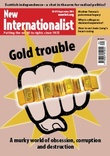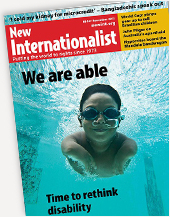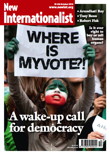Modern goldmining has developed a Midas touch, turning low-grade deposits into vast wealth but with devastating consequences: over 900 farmers poisoned by a mercury spill in the mountains of Peru; Akyim indigenous people from Ghana forced from their forest homeland; an Indonesian bay and fishing community contaminated by arsenic and mercury; the Western Shoshone nation in Nevada deprived of their treaty rights and ancestral land.
These are just some of the accusations levelled at one of the new kings of the global gold empire, the Newmont Mining Corporation.
And still, Newmont markets itself as an ethical gold producer. The company has ISO (International Organization for Standardization) certification for environmental management and has slithered onto the Dow Jones Sustainability Index for seven consecutive years.
Newmont also belongs to several organizations and conventions with impressive names like the United Nations Global Compact, the Voluntary Principles on Security and Human Rights, and the Partnering Against Corruption Initiative.
Sounds reassuring until you read the small print: membership in these groups is voluntary and reporting is usually done by the companies or auditors in their pay. Even when third-party auditors exist, companies accused of human rights violations, like Newmont, continue to sneak onto the roster.
It’s not fair just to pick on Newmont, though. All the major gold companies have been accused of human rights abuses and contamination and they’ve jumped with glee into the cleansing suds of the new image-washing machine: that oxymoron called ‘corporate responsibility’.
Damaging footprint
Robert Moran, a scientist who has worked for over four decades on water issues in the mining industry, says that most goldmines operate like ‘private fiefdoms’. Government officials need permission before visiting sites, and technical data and information is supplied by the companies, including the types of chemicals used and make-up of waste materials. During his long career, Moran says, ‘I’ve never seen a long-term sustainable mine when it comes to water resource issues.’
But the public has gotten wise, and rising opposition to new mines around the world has sent shivers through the industry. Even Wall Street junkies are worried: stock prices are affected by social unrest.
Two years ago, Newmont’s Minas Conga project, which would have destroyed several lakes in the Peruvian mountains, was put on hold due to local opposition. Today Newmont is still trying to convince nervous investors that the mine is going ahead, despite hundreds of farmers camped out by the lakes, determined to keep the company’s machinery out.
The conflict has made front-page news in the business world, yet ethical investment firms, including the US-based Christian Brothers, continue to offer Newmont stock in their portfolios.
So-called ethical investors defend their cosy relationship with the gold industry saying they ‘challenge’ the companies, writing harshly worded letters and filing shareholder resolutions. But how effective can they be if they consistently fail to change the way companies operate on the ground? Do they merely provide corporations with green stars they don’t deserve?
The contradictions leave many socially conscious investors wondering if there’s such a thing as ‘ethical gold’, or if it’s just another corporate fairy-tale.
Certified clean?
A decade ago, a coalition of non-profits led by Earthworks and Oxfam decided to tackle this problem and launched a campaign called No Dirty Gold. Over 100 jewellery stores, including 8 of the top 10 US retailers, signed the ‘Golden Rules’ pledge, promising not to buy gold from companies associated with human rights and environmental abuses.
This prompted the rather sticky question – how do jewellers ensure they’re buying ‘clean’ gold?
Always eager to please, the jewellery industry set up a certification organization called the Responsible Jewellery Council (RJC) which would direct consumers and jewellery companies to clean, green gold. The RJC has more than 450 member companies from goldmines to refineries to jewellery stores.
But, in a report called More Shine than Substance, environmental and labour groups claim the RJC uses weak standards, especially regarding the environment and workers’ rights, and lacks transparency. A quick glance at the RJC’s membership reads like a ‘Who’s who’ of companies accused of human rights violations.
There’s goldmining giant Rio Tinto, whose reputation is so tarnished that environmental and human rights groups protested its contract to provide the 2012 Olympic medals. Another member is gold refinery Argor-Heraeus SA, under investigation in Switzerland for buying gold from an illegal armed group in the Democratic Republic of Congo. Profits from the sale of ‘conflict gold’ in the Congo help fuel a bloody civil war responsible for almost six million deaths since the 1990s.
Two other RJC members, MKS Finance and its subsidiary PAMP, both reputable Swiss gold processing firms, have been accused of buying illegal gold from Peru’s Amazon. More than 40,000 hectares of Peru’s Amazon has been devastated by illegal goldmining and the industry has been accused of human rights abuses ranging from poisoning workers with mercury to forced labour and sex trafficking of young girls.
Survival mining
Large certification schemes like the RJC often have difficulty tracking gold from the mine to the consumer. Smaller certification labels have had more success: like Fairtrade gold, from the Fairtrade coffee people, and Fairmined gold, by the Alliance for Responsible Mining (ARM). Each certifier works directly with communities in Latin America and Africa that produce artisanal gold, ensuring traceability.
According to Fairtrade International, about 100 million people worldwide earn a living from artisanal and small-scale mining. Although artisanal miners produce only about 10 per cent of the world’s gold each year, they make up about 90 per cent of the workforce in goldmining, providing important financial support for their families.
‘The miners are fighting against poverty,’ says Manuel Reinoso, vice-president of ARM. ‘It’s not like big mining that exploits workers and takes 90 per cent of the profits out of the country and leaves nothing behind.’
Reinoso knows the hardships facing artisanal miners first-hand; the elderly Peruvian has earned his muscular arms and trim frame from a lifetime of labour in the mines.
Gold mines operate like 'private fiefdoms'. Government officials need permission before visiting sites.
He admits there are still environmental issues with certification – not all ARM and Fairtrade gold is free from mercury and cyanide. Reinoso says they’re working towards phasing out chemicals, but it’s going to take time and money.
ARM has pilot projects in Africa using chemical-free gravimetric methods for gold recovery. And Fairtrade has created the ‘Ecological Gold’ label for gold that has been produced without chemicals. But even without mercury or cyanide, mining leaves a major ecological footprint, especially in sensitive areas like rainforests and watersheds.
This means that programmes like Fairtrade and Fairmined have to remain small; if they try to scale up, they’ll no longer be sustainable.
Many environmentalists, like Eduardo Gudynas, argue that no goldmining can be considered ‘sustainable’. Gudynas has called for a moratorium on goldmining in Latin America.
Only nine per cent of our gold consumption goes into electronics and medical equipment; the rest is used in jewellery and the financial sector. According to the World Gold Council, recycling already accounts for a third of the total supply of gold and is on the rise, meaning our technology and medical needs could be met without any new goldmining.
This would require an overhaul of our economic system, challenging the jealous gods of over-consumption, and finding new jobs for the artisanal miners.
Not too long ago respectable people bought ivory and flaunted sealskin coats. Could gold stocks and wedding rings become the next taboo item, symbols of war, greed and environmental destruction?
One thing is certain: if we keep supporting ‘dirty gold’, we could end up like subjects of a modern King Midas: destroying our natural resources for gold and realizing all too late that there’s nothing left to eat or drink.
 This feature was published in the September 2014 issue of New Internationalist. To read more,
buy this issue
or subscribe.
This feature was published in the September 2014 issue of New Internationalist. To read more,
buy this issue
or subscribe.
![buyat-baby-memorial_opt.jpeg [Related Image]](https://webarchive.library.unt.edu/dentonfracking/20141030000327im_/http://newint.org/features/2014/08/15/buyat-baby-memorial_opt.jpeg)



Comments on The myth of ethical gold
Leave your comment
Registration is quick and easy. Plus you won’t have to re-type the blurry words to comment!
Register | Login
...And all is quiet.
Subscribe to Comments for this article
Guidelines: Please be respectful of others when posting your reply.